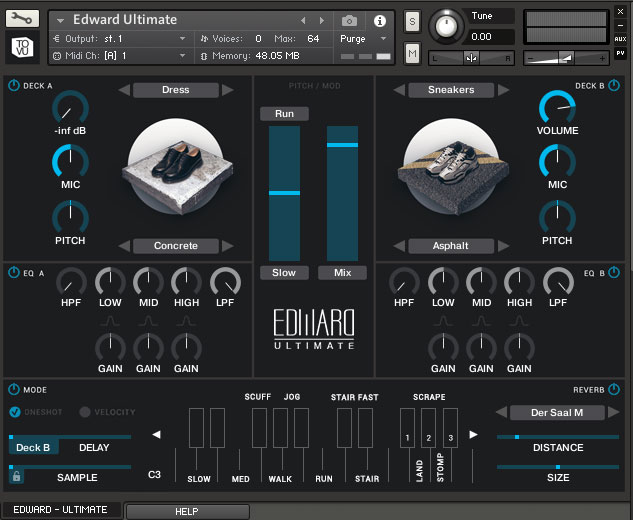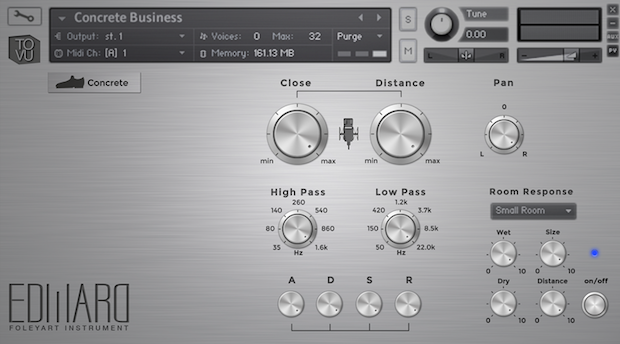New Software Review: Edward Ultimate Foleyart Instrument from Tovusound
 The landscape of post-production mixing tools available—especially for budget-conscious engineers working on independent projects—is constantly expanding.
The landscape of post-production mixing tools available—especially for budget-conscious engineers working on independent projects—is constantly expanding.
I’ve had the pleasure of working with and reviewing some really unique software-based foley products for SonicScoop in the past, so when a regular reader emailed me to insist I check out Tovusound and their “Edward” Foleyart Instrument for Native Instruments’ Kontakt platform, I had to take a look.
Edward Ultimate is a software-based foley pack that allows users to “play” footsteps along to picture for film and television projects. The plug-in offers control over a variety of types of shoes, surfaces and footsteps in an effort to allow you to create a unique and realistic foley performance from within your DAW.
Tech Specs
Tovusound’s Edward Ultimate Footsteps currently sells for $299 MSRP, with more limited versions available for as little as $49, and in a larger bundle that includes clothing and prop sounds for $499.
Edward works with Native Instruments’ Kontakt Version 5.4.1 or higher (not included!). The plug-in requires Mac OS X 10.8 or higher, Intel Core 2 Duo or Windows 7 or higher, Intel Core 2 Duo or AMD Athlon™ 64 X2, 4GB of RAM, and a 64-bit compatible DAW. Stereo and 5.0 versions are also available.
Features and Use
I found the user interface of Edward Foleyart Instrument to be very intuitive. The layout is simple, offering several sections that provide all the features you’ll need, right at your fingertips.
The top two main sections—“Deck A” and “Deck B”—allow you to load two different types of shoes and surfaces, and blend them together if desired.
Each deck has individual knobs for Volume, Pitch, and most impressively, a Mixer pot for blending between two different microphones: A Sennheiser MKH 416 when the knob is turned fully left, and a Neumann KMR 81i when the knob is turned right.
Below the main decks are controls for EQ and Reverb, as well as a very helpful virtual MIDI keyboard built into the plug-in. I’m a big fan of having access to the keyboard within the plug-in, as it saves me from having to pull up the manual every time I want to use Edward Ultimate.
The thing that’s always surprising about foley footsteps is that you don’t realize just how many different ways a shoe or footstep can sound until you’re attempting to re-create it realistically in post! One of the features I loved most about the Tovusound Edward Ultimate pack is the sheer comprehensiveness of its sound library.
On the keyboard, the white keys provide walking samples at various speeds. Starting from the left with SLOW and MED, the steps increase in speed as you move right to WALK, RUN, a set of samples for footsteps on stairs, and finally, LAND and STOMP samples. The LAND and STOMP samples are incredibly helpful for when a character simply comes to a stop at the end of a walk. The black keys provide additional sounds such as SCUFF, JOG, STAIR FAST and SCRAPE.
One additional feature that makes the Edward Instrument so easy to work with is its built-in sample randomizer. This allows the plug-in to play one of ten available samples at random each time a key is selected. Alternately, you can lock the sample randomizer so that Edward will begin playing from a pre-selected sample, giving you predictable results each time you play back your session.
Finally, Tovusound has included two ON/OFF switches which control the ONESHOT and VELOCITY features.
ONESHOT allows you to control whether the selected sample plays to its end or cuts off precisely when the key is released. (Edward defaults to playing the sample through completely each time a key is pressed, which I found creates the most realistic sounding performance.)
The VELOCITY switch allows you to control whether the sample volume is affected by how hard the notes are played on the keyboard. It’s worth noting that unlike some foley packs, Edward does not play a unique sample at different velocities but rather plays the same sound at different volumes when the velocity is function is turned on.
The following are the available shoes and surface samples for use in the Edward Ultimate Pack:
Shoes
- Sneakers
- Boots
- Dress
- Heels
- Flat
Surfaces
- Asphalt
- Carpet 1
- Carpet 2
- Concrete
- Creak 1
- Creak 2
- Diamond
- Grass
- Grate
- Gravel
- Rectangle Wood
- Creaky Wood
- Parquet
- Cut Wood
- Swiss Dock
- Boat Wood
- Linoleum
- Marble
- Metal
- Puddle
- Rocks
- Snow
- Tiles
- Water 1
- Water 2
There is also a huge list of available reverb types, including Staircase, Carpark, Kitchen, Living Room, and many more to add ambience to your sounds as needed. The variety of shoes, surfaces and reverbs offer a virtually endless combination of soundscapes.
So, how does it sound? In a word, fantastic! I was fortunate enough to use Tovusound’s Edward Ultimate pack while mixing two different independent feature films: Do You Take This Man directed by Joshua Tunick and Bwoy directed by John G Young. The Edward plug-in allowed me to quickly and efficiently dial in the necessary footsteps for a wide variety of scenes, from sneakers in a kitchen to shoes on dirt, and even grass outdoors.
I was blown away by the crisp sound of each recording, along with the vast library of available shoes and surfaces. The ability to blend the two mics together as needed is a phenomenal feature that provides great realism. The default mic (Sennheiser) on the far left of the “Mic” knob sounds darker and warmer, and as you move the blend more towards the mic on the right (Neumann), the sound becomes sharper and more crisp. This is a great way to “EQ” your footsteps without actually engaging the EQ.
The intuitive layout of Edward allowed me to get working very quickly after loading the plug-in into Kontakt; no need to sift through the user manual. It’s also worth noting that the Edward plug-in loaded up fast, even on my soon-to-be-upgraded 2010 Mac Pro.
Summing it Up
The Edward Ultimate pack is a spectacular tool for post-production mixing, and comes in at a price point that should be well within means for anyone working on serious video projects. It’s a plug-in that could easily become a staple in any engineer’s arsenal for mixing film and television at any level.
In addition, Tovusound also offers an excellent selection of add-on packs for use with Edward, such as the Ultimate Clothes – Props Instrument. Priced at $149, this add-on features additional “mixers” for the Edward Instrument, offering many varieties of bags, chains, and different types of clothing to blend in alongside the footsteps for added realism.
I was also able to test drive the EDV3RB – Rooms with IRs pack ($59-79). This collection, for use in Audio Ease Altiverb 7, features fifteen post-production based reverbs such as Bunker, Factory, Kitchen and Living Room. EDV3RB even comes with a collection of room tones recorded in each of these settings. While room tones may not be the “sexiest” thing, they are quite possibly the most underrated asset among the heavily used FX palates in the post-production world. It is always helpful to have well-recorded clean room tones for use on my projects.
Based on these packages, I’ve become a big fan of Tovusound, and I look forward to seeing what foley and FX products they will have to offer in the future. I wouldn’t hesitate to recommend the Edward Ultimate pack to any independent post-production mixer.
Zach McNees is a Brooklyn-based producer/engineer/mixer and live recordist whose work includes Björk, Rob Thomas, The Gregory Brothers, Pixies, and many more. Zach’s post-production work includes House Hunters International (HGTV), VICE (HBO), All-American Makers (Science Channel) and the award winning documentary short “For The Love of Dogs”. Get in touch with Zach at http://www.zachmcnees.com.







